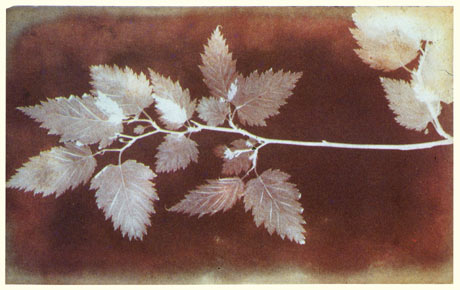Cliché-verre
Impact
of the Discovery of Photography
The
development of photography in 1839 by Fox
Talbot in England and Daguerre in France
had considerable impact on traditional
printmaking. Artistically, as in painting,
it suggested new compositional devices
and viewpoints, and gave insight into the
two-dimensional representation of movement.
Technically it made reproductive engraving
redundant and focussed traditional printmaking
techniques entirely on original artistic
expression.
Long
before photography was adapted to the reproductive
processes of photogravure and collotype
(photolithography), the light-sensitive
properties of photographic paper suggested
exciting new possibilities in artists’ original
printmaking, methods involving no camera,
but where the artist himself hand-drew
and printed an original photograph, what
has been evocatively called “etching
with light”.
Photogenic
Drawing
Fox
Talbot first described the basic principle
of photography, in a paper to the Royal
Institute in 1839, as "photogenic
drawing"
(see right and below).

William
Henry Fox Talbot (1800-1877): “Leaves”.
‘Photogenic drawing’ c1838.
He
placed an opaque object (a fern leaf) on
light sensitive paper (paper impregnated
with silver chloride) and exposed it to
sunlight. The light turned the paper black
except where it was covered by the fern.
The ‘white’ negative image
of the fern was fixed by immersing the
sheet in a solution of alkaline bromide
and chloride.
English prints from glass, etched
with light
It
was a logical extension to reverse the
scheme and only allow the sun to penetrate
positively through a linear design hand-drawn
by an artist into an opaque ground.
Talbot himself recognised this as early as 1834 and organised a few experiments while he was in Bellagio; though having no artistic pretensions he asked others to draw on his glass plates.
By
1839 the process was attracting wider interest and William Havell, his brother Frederick
and fellow landscape artist, James Tibbits
Willmore, exhibited photographic drawings
at the Royal Institute that year. They covered a
glass plate with etching ground and drew
into it. Laid against light-sensitive paper
in sunshine, the sun exactly transferred
the artist’s drawing from the glass
to the paper. Sadly, with the exception of an earlier ‘Talbot’ experiment, no impressions of these
"photographic drawings", English
anticipations of the French clichés-verre, have
survived. A record does remain of a charming
cliché-verre drawn on coated glass,
by the caricaturist George Cruikshank, in
1851. It is a ‘Pickwickian’ portrait
of Peter Wickens Fry (died 1860), an early
amateur photographer and founder member of
the London Photographic Club, who is shown
looking through a lorgnette at a piece of
paper, obviously a cliché-verre print,
with above him the caption “Etched
on glass. Dear me! how very curious!”.
French
cliché-verre
In
1853 independently in France similar experiments
were made by the amateur landscape photographer,
Adalbert Cuvelier, and christened cliché-verre "glass
prints". A French refinement was to paint
the design in either oil paint or printing
ink on the glass and dust it with powdered
white lead or collodian. The varying densities
of the ‘emulsion’ controlled
the amount of sunlight that could filter
through to ‘colour’ the light
sensitive paper, so that the artist
could print in tones from pale grey through
to black. A thick white collodian emulsion
of uniform density could also be used as
a ground into which a purely linear motif
was drawn.
Cliché-verre
is almost exclusively associated with Corot
(see right) and the Barbizon landscape
painters, and largely confined to the 1850’s
and 1860’s.

Théodore
Rousseau (1812-1867): “The Cherry
Tree at La Plante-à-Biau”.
Cliché-verre,
c1862. (217 x 275 mm)
Barbizon
on the outskirts of the Forest of Fontainbleau
had already attracted regular visits from
landscape painters wishing to paint in
the open air (plein-air) directly
from nature. The 1848 Revolution in Paris
determined the permanent migration of J F
Millet and Charles Jacque. Constant Dutilleux
and Daubigny were regular guests at the village
inn (as were Georges Sand, the Goncourts
and other romantics). Adalbert Cuvelier
visited annually bringing his photography
students from Arras. In 1859 his son Eugène
married the inn-keeper’s daughter
and settled in Barbizon. Eugène
Cuvelier showed the cliché-verre
process to Millet, Rousseau (see illustration
above) and Daubigny (see illustration
above right) and printed their
glass plates, which remained in his possession.
Few early impressions (printed on thin salted
or albumin paper) have survived.
The
Cuvelier collection of cliché-verres
was re-printed in small editions of 10-15
prints in 1911 when it was acquired by
Bouasse-Lebel. The plates passed to Le
Garrec, successor to Edmund Sagot at the
Galerie Sagot-Le Garrec, who printed the
principle edition (150) before chipping
the corners of the glass plates as cancellation
and giving them to museum collections.
The Le Garrec impressions are on gelatine
paper and retain the photographically printed
scratches and fingerprints in the borders
and the ‘black’ edge of the
glass plate. |